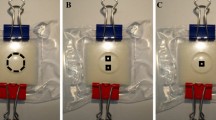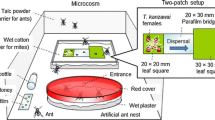Abstract
The between-plant movement of the predatory mite Phytoseiulus persimilis was studied in a greenhouse. The aims were to determine the distance moved by P. persimilis and the response of the predator to the location of a plant infested with two-spotted spider mite, Tetranychus urticae. In addition, we tested whether the predator exhibits random movement between plants or whether its dispersal is oriented. We found that a high proportion of the predators released on a central plant were able to reach plants at the periphery provided the plants were connected to the central plant with 'bridges'. The results further showed that P. persimilis does not disperse randomly to the surrounding plants. The distribution of immigrants was influenced by the position of an infested plant in the neighbourhood, but light/shadow effects in the greenhouse may also influence the choice of direction. The likely implications of the findings for biological control are discussed. © Rapid Science Ltd. 1998
Similar content being viewed by others
REFERENCES
Bartoš, J., Štaif, J, and Táborský, V. 1978. [Predatory mite Phytoseiulus rigeli Dosse and its use for Biological Control of Spider Mites in Glasshouses.] ÚVTIZ, Prague (in Czech).
Batschelet, E. 1981. Circular Statistics in Biology. Academic Press, London.
Bernstein, C. 1981. Dispersal of Phytoseiulus persimilis [Acarina: Phytoseiidae] in response to prey density and distribution. PhD thesis, University of Oxford.
Bernstein, C. 1983. Some aspects of Phytoseiulus persimilis [Acarina: Phytoseiidae] dispersal behaviour. Entomophaga 28: 185-198.
Bernstein, C. 1984. Prey and predator emigration responses in the acarine system Tetranychus urticae — Phytoseiulus persimilis. Oecologia 61: 134-142.
Charles, J.G. and White, V. 1988. Airborne dispersal of Phytoseiulus persimilis (Acarina: Phytoseiidae) from a raspberry garden in New Zealand. Exp. Appl. Acarol. 5(1–2): 47-54.
Dicke, M., Sabelis, M.W., Takabayashi, J., Bruin, J. and Posthumus, M.A. 1990. Plant strategies of manipulating predator-prey interactions through allelochemicals: prospects for applications in pest control. J. Chem. Ecol. 16(11): 3091-3118.
Dicke, M., van Baarlen, P., Wessels, R. and Dijkman, H. 1993. Herbivory induces systemic production of plant volatiles that attract predators of the herbivore: extraction of endogenous elicitor. J. Chem. Ecol. 19(3): 581-599.
Dong, H. and Chant, D.A. 1986. The olfactory response of three species of predaceous phytoseiid mites (Acarina: Gamasina) to a prey tetranychid species. Int. J. Acarol. 12(1): 51-55.
Durand, D. and Greenwood, J.A. 1958. Modifications of the Rayleigh test for uniformity in analysis of two-dimensional orientation data. J. Geol. 66: 229-238.
Everson, P. 1980. The relative activity and functional response of Phytoseiulus persimilis [Acarina: Phytoseiidae] and Tetranychus urticae [Acarina: Tetranychidae]: the effect of temperature. Can. Entomol. 112: 17-24.
Fisher, N.I. 1993. Statistical Analysis of Circular Data. Cambridge University Press, Cambridge.
Greenwood, J.A. and Durand, D. 1955. The distribution of length and component of the sum of n random unit vectors. Ann. Math. Stat. 26: 233-246.
Havelka, J. and Kindlmann, P. 1984. Optimal use of the 'pest in first' method for controlling Tetranychus urticae Koch (Acarina, Tetranychidae) on glasshouse cucumbers through Phytoseiulus persimilis A.-H. (Acarina, Phytoseiidae). Z. Angew. Entomol. 98: 254-263.
Hussey, N.W. and Parr, W.J. 1963. The effect of glasshouse red spider mite (Tetranychus urticae Koch) on the yield of cucumbers. J. Horticult. Sci. 38: 255-263.
Hussey, N.W. and Scopes, N.E.A. 1985. Greenhouse vegetables (Britain). In Spider mites, their biology, natural enemies and control, Vol. 1B, W. Helle and M.W. Sabelis (eds), pp. 285-297. Elsevier, Amsterdam.
Jarošík, V. and Plíva, J. 1990. Efficient control of twospotted spider mite Tetranychus urticae Koch by Phytoseiulus persimilis A.-H. on glasshouse peppers. J. Appl. Entomol. 110: 270-274.
Kennedy, G.G. and Smitley, D.R. 1985. Dispersal. In Spider mites, their biology, natural enemies and control, Vol. 1A, W. Helle and M.W. Sabelis (eds), pp. 233-242. Elsevier, Amsterdam.
Manly, B.F.J. 1997. Randomization, Bootstrap and Monte Carlo Methods in Biology, 2nd edn. Chapman & Hall, London.
Nihoul, P. 1993. Influences of the method of introduction of prey Tetranychus urticae and predators Phytoseiulus persimilis on the development of plant injury in tomato crops under glass. Exp. Appl. Acarol. 17(10): 765-774.
Ryoo, M.I. 1986. Studies on the basic components of the predation of Phytoseiulus persimilis Athias-Henriot (Acarina: Phytoseiidae). Res. Popul. Ecol. 28(1): 17-26.
Sabelis, M.W. 1985. Predation on spider mites. In Spider mites, their biology, natural enemies and control, Vol. 1B, W. Helle and M.W. Sabelis (eds), pp. 103-129. Elsevier, Amsterdam.
Sabelis, M.W. and Dicke, M. 1985. Long-range dispersal and searching behaviour. In Spider mites, their biology, natural enemies and control, Vol. 1B, W. Helle and M.W. Sabelis (eds), pp. 141-160. Elsevier, Amsterdam.
Sabelis, M.W. and van de Baan, H.E. 1983. Location of distant spider mite colonies by phytoseiid predators: demonstration of specific kairomones emitted by Tetranychus urticae and Panonychus ulmi. Entomol. Exp. Appl. 33: 303-314.
Sabelis, M.W. and van der Meer, J. 1986. Local dynamics of the interaction between predatory mites and two-spotted spider mites. In The dynamics of physiologically structured populations. Lecture notes in biomathematics, Vol. 68, J.A.J. Metz and O. Diekmann (eds), pp. 322-344. Springer-Verlag, Berlin.
Sabelis, M.W. and van der Weel, J.J. 1993. Anemotactic responses of the predatory mite, Phytoseiulus persimilis Athias-Henriot, and their role in prey finding. Exp. Appl. Acarol. 17(7): 521-529.
Schütte, C., Hulshof, J., Dijkman, H. and Dicke, M. 1995. Change in foraging behaviour of the predatory mite Phytoseiulus persimilis: some characteristics of a mite population that does not respond to herbivore-induced synomones. Proc. Exp. Appl. Entomol. NEV Amsterdam 6: 133-140.
Schütte, C., van Baarlen, P., Dijkman, H. and Dicke, M. 1996. How can predatory mites lose their response to plant signals? Proc. Exp. Appl. Entomol. NEV Amsterdam 7: 195-196.
Siegel, S. and Castellan, N.J.J. 1988. Nonparametric Statistics for the Behavioral Sciences. McGraw-Hill Book Company, New York.
Takafuji, A. 1977. The effect of the rate of successful dispersal of a phytoseiid mite, Phytoseiulus persimilis Athias-Henriot (Acarina: Phytoseiidae) on the persistence in the interactive system between the predator and its prey. Res. Popul. Ecol. 18(2): 210-222.
Tomkiewicz, J., Skovgård, H., Nachman, G. and Münster-Swendsen, M. 1993. A rapid and nondestructive method to assess leaf injury caused by the cassava green mite, Mononychellus tanajoa (Bondar) (Acarina: Tetranychidae). Exp. Appl. Acarol. 17: 29-40.
van de Vrie, M. 1985. Greenhouse ornamentals. In Spider mites, their biology, natural enemies and control, Vol. 1B, W. Helle and M.W. Sabelis (eds), pp. 273-283. Elsevier, Amsterdam.
Zemek, R. and Nachman, G. 1998. Interactions in a tritrophic acarine predator-prey metapopulation system: effects of Tetranychus urticae on the dispersal rates of Phytoseiulus persimilis (Acarina: Tetranychidae, Phytoseiidae). Exp. Appl. Acarol. 22: 259-278.
Zhang, Z.-Q. and Sanderson, J.P. 1992. Short-distance location of spider mite colonies by three predatory mites (Acari: Tetranychidae, Phytoseiidae): predator responses to prey-and predator-associated stimuli. Environ. Entomol. 21(4): 799-807.
Zhang, Z.-Q. and Sanderson, J.P. 1993. Behavioural responses to prey density by three acarine predator species with different degrees of polyphagy. Oecologia 96: 147-156.
Author information
Authors and Affiliations
Rights and permissions
About this article
Cite this article
Zemek, R., Nachman, G. Interactions in a tritrophic acarine predator– prey metapopulation system: prey location and distance moved by Phytoseiulus persimilis (Acari: Phytoseiidae). Exp Appl Acarol 23, 21–40 (1999). https://doi.org/10.1023/A:1006156931391
Issue Date:
DOI: https://doi.org/10.1023/A:1006156931391




